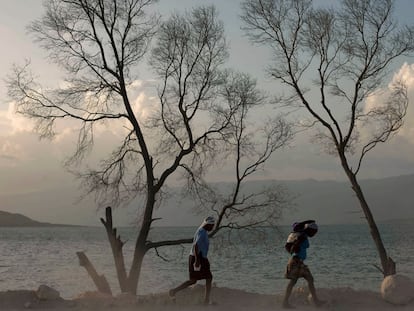The misery and politics of Haiti’s cholera epidemic
A wave of protests paralyzed the Caribbean country in late 2022, causing water shortages and outbreaks of infectious diseases
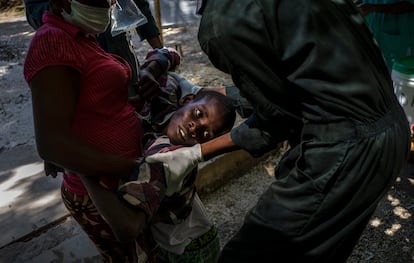

The people peacefully fill their water buckets in Port-au-Prince, Haiti’s capital city. It’s Friday, and the kids are in school. It won’t get crowded until early tomorrow morning. They fill big white paint buckets from a wide plastic pipe that juts up between the roots of a tree on a hill. “It’s clean,” says Richie Alexei, who waits his turn to fill.
Alexei’s trust in the water’s purity isn’t based on science but on the experience of someone who has consumed it many times. The ravine with the water pipe is heavily littered with garbage, plastic bottles and polystyrene containers. Alexei says fifty feet away is another tube – that water is bad.
It’s hard to find potable water in Haiti, or at least clean enough to drink. The three million people in the capital’s metropolitan area live on the brink of catastrophe in a city besieged by institutional collapse, violence, and a health crisis. They’re always thinking about water, finding water, clean water.
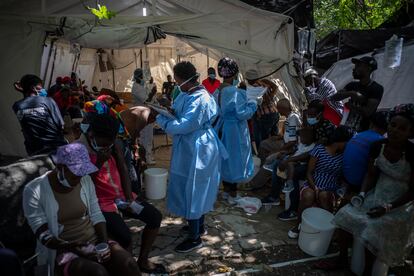
Three years after the last outbreak, cholera invaded Haiti again in October 2022. In 2010, the disease ravaged the population after the terrible earthquake that killed more than 200,000 Haitians. Nearly a million people were infected, and 10,000 died in one of the worst outbreaks in the country’s history.
Cholera, contracted by consuming contaminated water, reappeared at the end of last year amid the country’s political and social chaos and has caused more than 450 deaths. Haiti was wracked by widespread, violent protests after fuel prices more than doubled. Then a criminal gang hijacked the fuel storage terminal in the capital’s port.
The country was paralyzed. With no diesel to power generators, much of the population lacked electricity, and no gasoline meant no deliveries of bottles of potable water. In Haiti, public water and electricity systems are utopian dreams, so the pipe where Alexei gets his water is one of the few options available to many. But not everyone can get into the hills to fill their water buckets, so the only option in the lower parts of the city is to dig wells. In densely populated and impoverished neighborhoods with contaminated soil, that’s like shooting yourself in the foot.
Martin Schüepp, director of operations for the International Committee of the Red Cross (ICRC), visited Port-au-Prince recently to see firsthand the conditions in the city. “Cholera has to do with a total lack of sanitation and medical services in densely populated areas,” said Schüepp, “and many clinics and hospitals have trouble functioning because of insecurity.” The ICRC, which returned to Haiti in 2021 after a four-year absence, is now helping other Red Cross agencies based in the country to operate cholera programs.

On Saturdays, everyone fights for water
The ongoing problem of violence causes doubt about whether the epidemic can be controlled. In the Turgeau neighborhood near the city center, Doctors Without Borders runs a hospital with a special cholera treatment unit. The doctor in charge, Jean Marc Biquet, says they treated one of the first cases of this outbreak, which now numbers 13,000 cases. Infections have been decreasing recently, making him think the epidemic is under control. But everyone wonders what will happen if Haiti is paralyzed again like last year.
Down the ravine, about 100 yards from the “good water” pipe, women and men wash mountains of clothes in large tubs. They look somewhat happy, perhaps because they can forget their problems for a while. The weather is cool, and there is plenty of room to bathe. Some do just that. “It looks quiet now, but on Saturdays, everyone fights for water,” says one woman.
Felisa Albert wrestles with her pile of washing. She usually comes on Saturdays, but she already had so much to wash this week that she decided to come a day earlier. Sundays, she comes to collect water to take home. Mingling with the people at the water pipe are some of the goats that overrun Port-au-Prince, much like the cats in Istanbul or the dogs in Santiago de Chile.
Albert’s life is a lesson in harsh Caribbean poverty. She comes to wash in a tap-tap, the gaily painted collective taxis that daily test drivers’ patience in Port-au-Prince. On water collection days, she and her children walk a three-hour round trip with eight buckets. “It’s because where I live up in the mountains, they charge 75 gourdes [$0.50] a bucket,” she explains.
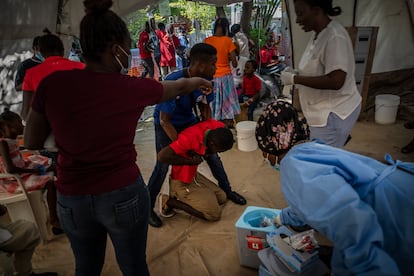
The water Albert takes home is used for cooking, washing and sometimes drinking. “If there is money, we buy a big bottle of water,” she said, “but they cost 100 gourdes, and sometimes there is none to buy.” They add purification tablets to make water from the pipes drinkable, and to make doubly sure, they also boil it. Here in the ravine, cholera seems far away. A passerby says that many people in Haiti think it [cholera] is a political thing, a government thing.
How can you blame anyone for thinking that way? In Haiti, everything is political. Violence, famine, inflation, fuel – everything. Dr. Miquel Angel Ramon, a member of Haiti’s Doctors of the World team, is not surprised by the political slant of how people view cholera here. “It’s evident that cholera arrived here because of the United Nations mission after the 2010 earthquake.” The UN reconstruction team included Nepalese workers who brought the bacteria that causes cholera.
Dr. Ramón believes that prevention work in these situations is crucial. “We try to disseminate easy-to-understand information about cholera’s history and biology. We tell them it’s transmitted in feces-contaminated water and happens in many places worldwide, especially during famines.” But in places like Haiti, the relentless deprivation offers few choices – a contaminated well or a distant water pipe.
Sign up for our weekly newsletter to get more English-language news coverage from EL PAÍS USA Edition
Tu suscripción se está usando en otro dispositivo
¿Quieres añadir otro usuario a tu suscripción?
Si continúas leyendo en este dispositivo, no se podrá leer en el otro.
FlechaTu suscripción se está usando en otro dispositivo y solo puedes acceder a EL PAÍS desde un dispositivo a la vez.
Si quieres compartir tu cuenta, cambia tu suscripción a la modalidad Premium, así podrás añadir otro usuario. Cada uno accederá con su propia cuenta de email, lo que os permitirá personalizar vuestra experiencia en EL PAÍS.
¿Tienes una suscripción de empresa? Accede aquí para contratar más cuentas.
En el caso de no saber quién está usando tu cuenta, te recomendamos cambiar tu contraseña aquí.
Si decides continuar compartiendo tu cuenta, este mensaje se mostrará en tu dispositivo y en el de la otra persona que está usando tu cuenta de forma indefinida, afectando a tu experiencia de lectura. Puedes consultar aquí los términos y condiciones de la suscripción digital.
More information
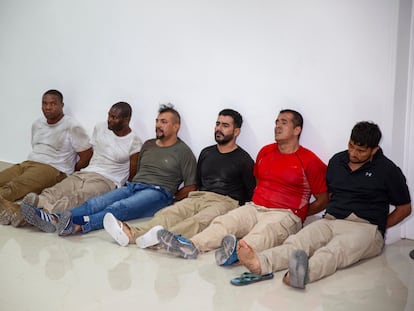
Four key suspects in Haiti presidential slaying in US custody
Archived In
Últimas noticias
Maduro pleads not guilty before the federal court in New York: ‘I am still the president of Venezuela’
A new test can detect Alzheimer’s from a finger prick
UN team enters Sudanese city of El Fasher after paramilitary massacre: ‘It’s like a ghost town’
A recipe for resistance: Indigenous peoples politicize their struggles from the kitchen
Most viewed
- Gilles Lipovetsky: ‘If you want to live better and fall in love, take Prozac, don’t look to philosophy’
- Alain Aspect, Nobel laureate in physics: ‘Einstein was so smart that he would have had to recognize quantum entanglement’
- Alvin Hellerstein, a 92-year-old judge appointed by Bill Clinton, to preside over Maduro’s trial in New York
- Why oil has been at the center of Venezuela-US conflicts for decades
- Maduro’s downfall puts China’s relationship with Venezuela to the test
